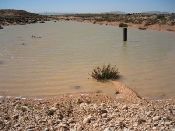|
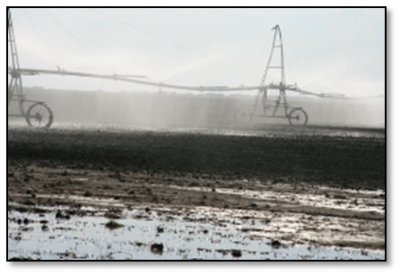 |
The Novy study site covering Marksovsky Region of Saratov Oblast is situated at left bank of Volga River, and has a semi-arid climate. A long warm and dry summer with little rainfall every second year makes an extensive rainfall based agriculture practically impossible. Considerable land use changes have taken place over the last 40 years while first large irrigation system been constructed based on sprinkler irrigation use.
|
This has caused regional ground water rising and secondary salinization appearing, as well as of developing of zones suffering of local runoff and water erosion by excessive irrigation. The collapse of the Soviet Union and increased socio-economic crises with rising prices of energy (pumping water from the Volga river), the use of irrigated land at Marksovsky Region diminished more than 5 times from its original size. Sprinkler irrigation was partly replaced by furrow irrigation, which is less expensive (no pumping) but has a low efficiency. as much water is lost because of low infiltration rates. This in fact generates soil erosion in the furrows and sedimentation of agrochemicals in nearby ponds.
Drip irrigation has a much better controlled application of water below the surface, which conserves water and prevents erosion.
Experiment: drip irrigation to conserve water and prevent erosion
|
Field trials were carried out to (1) investigate the causes of negative impacts of both sprinkler and furrow irrigation technologies on the land and water resources and their degradation as well as (2) to test new and adapted irrigation technologies aiming to improve irrigation impact on these resources by making it environment neural or friendly.
Both aims were achieved by dealing with experimentations and precise monitoring of soil moisture and water fluxes developed at plot and field scale with farm conventional sprinkler irrigation and spatially variable irrigation rate (like alternative to conventional one) of alfalfa, furrow and drip irrigation (like alternative to furrow one) irrigation of tomatoes. |
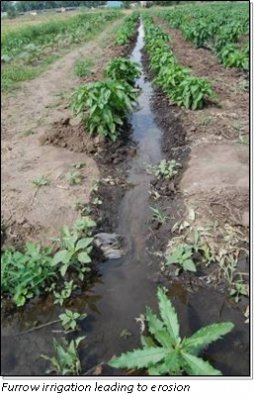 |
The experimental field scale plots irrigated by furrow technology were established in 2008 and monitored during two irrigation seasons from June till August 2008 – 2009. These plots were located at the irrigated areas of agricultural farm specialized on vegetables. These experimental fields were equipped with 10 boreholes providing access to capacitance soil moisture sensors to measuring soil moisture till 100 cm and 3 weirs established at one furrow with aim to measure water discharge at the beginning, middle and end parts of it. During both experimentation seasons 6 irrigation applications were proceeded and data on soil moisture, water discharge at furrows were recorded.

Experimental plot with dirp irrigation of tomatoes at the Sishkine family backyard |
The experimental plots irrigated by drip irrigation technology were established at the same time and at the same fields in parallel with experiments with furrow irrigations. Their were equipped with 4 boreholes providing access to capacitance soil moisture sensors measuring soil moisture till 40 cm. During season of 2010 an experimental plot with drip irrigation was established at garden of one householder at Mikhailovsky village. During all three experimental seasons a continuous drip irrigation applications were proceeded and data on soil moisture were recorded as well as meteorological parameters were recorded by automatic weather station located near these plots.
|
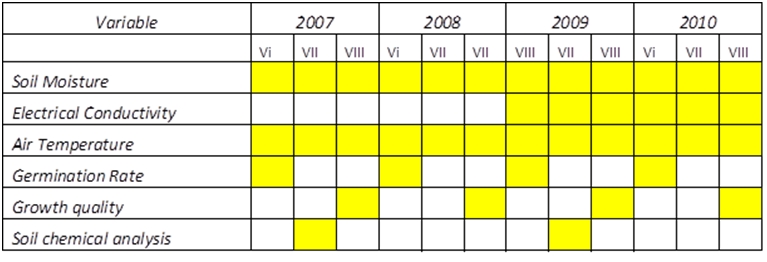
Monitoring schedule
During the monitoring period of 3 years, a total of 7 events of water irrigation by furrow irrigation were recorded. By this monitoring results it was shown high negative impact produced by water flowing in furrow on soil and down lading water objects as well as by infiltrated water raising ground water levels. Impact was produced by water erosion in furrows, chemicals used for plan nutrition and preferential flow to deep soil layers and ground waters.
During the monitoring period of 3 years a water regime under drip irrigation were recorded in totally during 11 months. It was shown a positive water regime without developing runoff, formation of water erosion and preferential flow to deep soil layers and ground water.
A comparison of amount of water used for both technologies of irrigation at the same meteorological conditions shows that furrow irrigation uses 5-7 times more water than drip irrigation with similar crop yields.
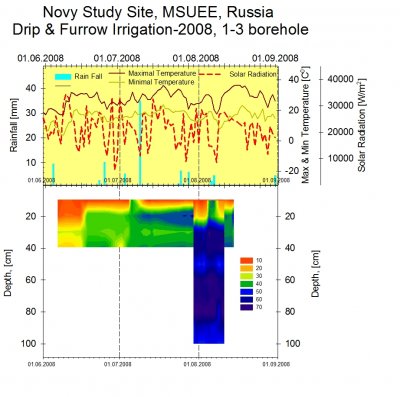 |
Comparison of soil moisture events measured simultaneously at drip irrigated plot in the range of 0 – 40 cm and at furrow irrigation plantation in the range of 0 – 100 cm
|
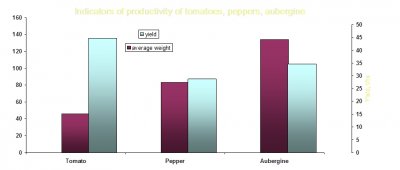 |
Indicators of productivity of tomatoes, peppers, aubergine
|
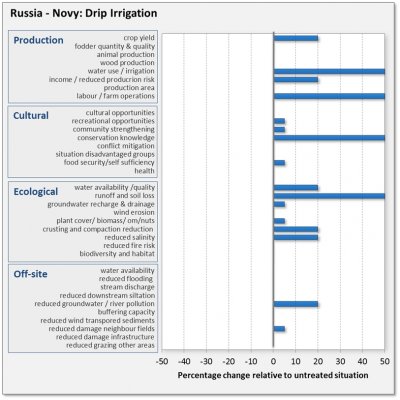 |
The results are evaluated from a production, socio-cultural and economic point of view. The bars express the estimated or measured percentage of change with respect to the reference situation. This change can be positive (blue) or negative (red). Note that this evaluation is based on the experiments, on the long term experience of the coordinating team in this area and on consultations with the farmers.
|
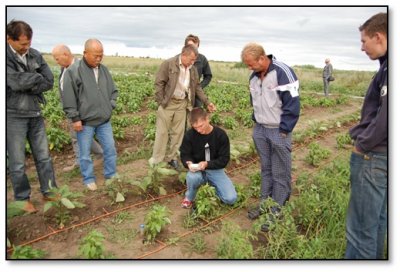 |
A lot of farmers and experts and administrations shown interest in SLM technologies to protect the land, the interest in advanced irrigation technology.
Drip irrigation is profitable compared to furrow irrigation practices since it does not increase the yield, but considerably reduce amount of applied water and workload.
|
Despite the implementation and maintenance costs, the drip irrigation may increases the benefits in water consumption as well as land and water resources protection against degradation and pollution.
| The traditional furrow irrigation of vegetables is a technology with high and inefficient water use: about 20-30% of water is absorbed by roots of growing plants and about 70-80% is lost, causing erosion. This obviously has an impact on the environment. |
| Drip irrigation technology improves the moisture regime and water availability in soil root zone by a permanent slow input that can be adjusted to seasonal and diurnal variation of water consumption of plants during growing season. Yields under both techniques are very similar. |
| However, Additional funds should be available to purchase drip irrigation systems. Not all farmers have access to a functioning system so for a large scale application considerable investments would be needed. A special regional drip irrigation supporting program is needed as well as an environmental protection program. Furrow irrigation systems could be taxed and excluding from the list of subsidy of energy needed for water transportation. This subsidy could instead be used for installation of drip irrigation systems. |
|

